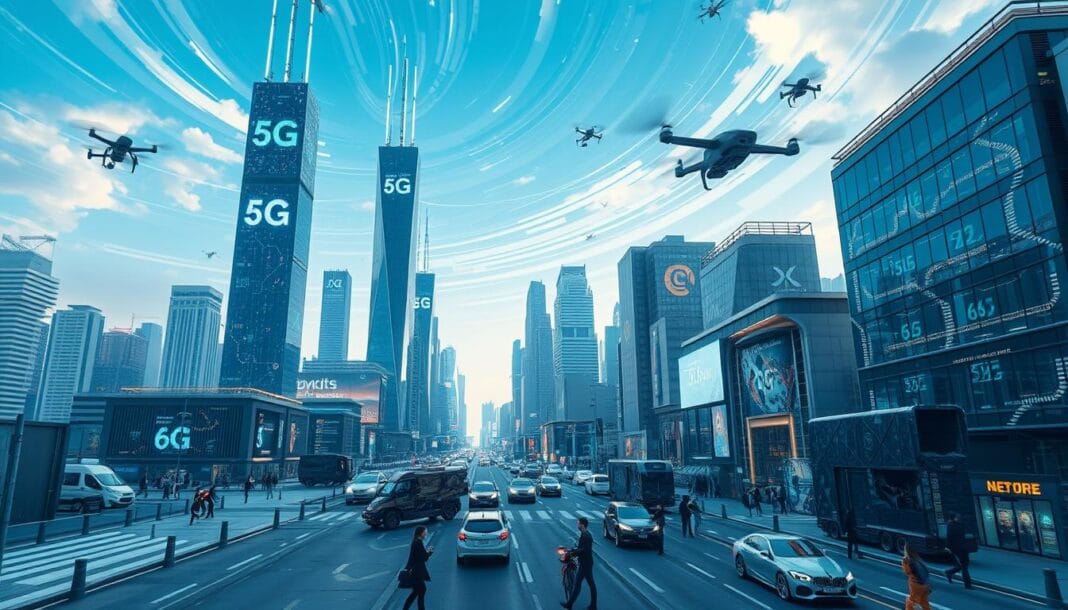Technology is advancing fast, and 5G and 6G networks are leading the charge. They will alter our lifestyle, employment, and recreation.
These new networks will make our lives faster, more connected, and full of new possibilities.
The Evolution from 1G to 6G: Understanding Network Generations
The journey of mobile networks has been amazing, from 1G in the 1980s to 5G today and 6G on the horizon. Each step has improved speed, capacity, and what we can do with our phones.
Mobile Network Development Key Milestones
1G networks started in the late 1970s and early 1980s. They allowed mobile voice calls but were not as good as later networks. Then, 2G came in the early 1990s, switching to digital and introducing GSM and SMS.
In the early 2000s, 3G networks arrived, bringing fast data and new features like web browsing and video calls. Later, 4G networks in the late 2000s used LTE technology for speeds up to 100 Mbps, making mobile internet better.
Speed and Capacity Improvements Across Generations
Each new generation has brought big improvements in speed and capacity. 1G was slow, 2G introduced digital and SMS, and 3G enabled the mobile internet. 4G networks then offered speeds up to 100 Mbps with LTE-Advanced.
5G, starting around 2019, has speeds up to 10 Gbps and very low latency. 6G is expected to be even faster, with speeds up to 100 Gbps and almost instant communication.
The Shift from Analog to Digital Communications
The move from analog to digital was key for mobile networks. 2G networks made this change, improving voice quality and adding data services like SMS and MMS. This allowed later generations to build on digital technology and expand mobile communication.
5G and 6G Networks: The Next Frontier in Connectivity
We are entering a new era of wireless technology. 5G technology and 6G research are set to change how we use the internet. These networks will impact our daily lives, work, and how we connect online.
5G networks are already fast, up to 100 times quicker than 4G. They also have very low latency, just 1 millisecond. With 5G+, which uses millimeter waves, speeds and capacity get even better. This unlocks fresh possibilities for uses.
6G networks aim to go even further. They could reach data rates of up to 1 terabit per second. This is 100 times faster than 5G, making for seamless and immersive experiences.
6G also promises ultra-low latency, possibly under 1 millisecond. This will make real-time interactions and ultra-responsive apps possible. Such advancements will benefit many industries, from healthcare to smart cities.
| Metric | 5G | 6G |
|---|---|---|
| Peak Data Rate | 10 Gbps | 1 Tbps |
| Latency | 1 ms | |
| Spectrum Range | Sub-6 GHz, Millimeter Wave | Terahertz (THz) |
| Connected Devices | 1 million per sq km | 10 million per sq km |
The world is excited about 5G technology and looking forward to 6G research. We are on the verge of a new era in mobile broadband. These networks will change how we communicate, work together, and experience the digital world. They will make connectivity seamless, responsive, and transformative.
Breaking Speed Barriers: From Gigabits to Terabits
The world of wireless communications is changing fast. The move from 5G to 6G networks will break speed records. 5G already offers speeds up to 10 Gbps, but 6G aims for terabit speeds.
Understanding Theoretical Speed Limits
Wireless network speeds are getting faster thanks to new tech and better use of spectrum. Experts say 6G could reach terabit speeds and have microsecond latency. This represents a substantial leap from 5G.
This improvement comes from exploring new frequency bands. The terahertz (THz) spectrum, from 100 GHz to 3 THz, is key.
Real-world Applications of Enhanced Speed
6G’s terabit speeds and low latency will open up new possibilities. Picture being able to download high-definition movies within seconds. Or having super-realistic virtual reality and augmented reality experiences.
These real-world 5G applications and more will change many areas of life. They will revolutionize how we work, play, and live.
| Network Generation | Speed Capabilities | Latency |
|---|---|---|
| 5G | Up to 10 Gbps | 1 millisecond |
| 6G | Up to 1 Tbps | 1 microsecond |
The 6G market is expected to grow a lot from 2024 to 2035. This is because of the need for enhanced mobile broadband and low latency. The world is excited for 6G, and companies are racing to make it happen.
Transforming Healthcare Through Advanced Networks
The world is moving fast with 5G and 6G networks. These new wireless technologies are changing healthcare in big ways. They’re making it possible for new medical care methods to emerge.
Telesurgery is at the forefront of this change. Skilled surgeons can operate on patients remotely. Thanks to 5G and 6G’s fast speeds, doctors can control operations in real-time. This means better care for more people, without the need for long trips.
Advanced networks are also changing real-time health monitoring. Now, devices can send important health data to doctors instantly. This helps doctors act fast and give care that’s just right for each person. The smartwatch market is growing fast, showing how much people want to track their health.
AI-driven diagnostics are another big step forward. 5G and 6G’s speed helps doctors quickly analyze lots of health data. This leads to better, faster diagnoses. It’s a big leap towards better health care for everyone.
The future of healthcare with 5G and 6G looks bright. These technologies will make health care better and more accessible. The changes are just starting, and they’re exciting.
Read more: Are We Ready? Quantum Computing is Revolutionizing Technology

| Metric | Value | Trend |
|---|---|---|
| Global Smartwatch Market Size | 134 million units (2023) | Projected to grow to 457 million units by 2028 (CAGR of 27.78%) |
| Real-time Data Transfer Latency | As low as 1 millisecond | Enabling real-time telesurgery and health monitoring |
| AI-driven Diagnostics Capabilities | Enhanced accuracy and efficiency | Improving early disease detection and personalized treatment |
The Revolution in Transportation and Autonomous Vehicles
The future of transportation is changing fast with 5G and 6G networks. These new wireless technologies are making autonomous vehicles and smart traffic systems better. They offer fast speeds, low latency, and great connectivity.
These networks make Vehicle-to-Everything (V2X) communication possible. This means vehicles can talk to their surroundings in real-time.
Smart Traffic Management Systems
5G and 6G networks are helping create advanced smart traffic management systems. These systems use connected vehicles, infrastructure, and data analytics to improve traffic flow. Reducing congestion helps enhance road safety.
These networks let autonomous vehicles make quick decisions. They can react fast to changes and drive more efficiently.
Vehicle-to-Everything Communication
V2X communication is key to this transportation change. It lets vehicles share important info with each other, pedestrians, and the cloud. This data exchange helps autonomous vehicles avoid hazards and move safely.
With 6G networks, this communication is almost instant. This makes autonomous systems even better at keeping us safe.
Enhanced Safety Features
5G, 6G, and autonomous driving technologies are making roads safer. 6G-enabled vehicles can react much faster than humans. This could cut accident risks by up to 90%.
This innovation is revolutionizing our way of traveling. It’s making our roads safer, more efficient, and sustainable for the future.
“The deployment of 6G technology is set to revolutionize business operations, enabling devices to support previously unattainable tasks due to technological constraints in various sectors such as healthcare and manufacturing.”
Cities focusing on sustainable environments.
The world is progressing towards a future with increased connectivity. Smart city infrastructure, powered by 5G and 6G networks, is key. These networks will change how we manage cities, making them more sustainable and improving life for city residents.
At the core of this change is IoT integration. Billions of devices will share data in real-time. This lets city officials make better decisions and find efficient solutions. From managing traffic to distributing energy, this smart city infrastructure will reduce waste and save resources.
The sustainable technology in smart cities is crucial for the environment. Advanced analytics and digital twins will help city planners. They can test changes and plan for emergencies, making cities more resilient.
| Key Smart City Sustainability Initiatives | Impact |
|---|---|
| Decentralized power generation through solar panels, microgrids, and energy storage systems | Reduced carbon footprints and reliable energy access |
| IoT-powered waste management and recycling programs | Efficient resource utilization and reduced landfill waste |
| Intelligent transportation systems with autonomous shuttles, smart traffic lights, and MaaS | Reduced congestion, improved air quality, and enhanced mobility options |
| Comprehensive environmental monitoring and analytics | Early detection of issues and data-driven decision-making for sustainability |
As we look to the future, 5G and 6G networks will lead the way. Cities will become more sustainable and enjoyable places to live in. With smart city infrastructure, IoT integration, and sustainable technology, we can build cities that are good for both people and the planet.

“The smart city revolution is not just about technological advancements; it’s about creating sustainable, resilient, and livable urban environments that prioritize the well-being of their citizens.”
Immersive Technologies: AR, VR, and Holographic Communications
As we look to the future, 5G and 6G will change our lives. They will make entertainment better with ultra-high-definition streaming and interactive experiences. This includes augmented reality (AR), virtual reality (VR), and holographic communication.
Next-Generation Entertainment
5G and 6G will make entertainment fast and smooth. Imagine watching virtual reality content in real-time. It will feel like you’re right there, in a 360-degree world.
These networks will also bring us holographic communication. This means we can have three-dimensional interactions. It will alter the way we experience entertainment.
Collaborating in Virtual Business Meetings
5G and 6G will also change work. Virtual meetings will feel more real and engaging. We’ll see holographic presentations and work together in virtual spaces.
This will improve working from a distance. Teams will be able to connect and work together in new ways.
The future of 5G and 6G is exciting. They will bring us ultra-realistic gaming and seamless holographic communication. This will open up a new world of entertainment, collaboration, and more.
“6G technology will support extended reality experiences, including virtual reality (VR), augmented reality (AR), and mixed reality (MR), enhancing immersive gaming, training simulations, and educational applications.”
Edge Computing and Applications with Ultra-Low Latency
The arrival of 5G and the upcoming 6G networks have changed the game for edge computing. This technology now allows for real-time data processing at the network’s edge. It’s key for fast applications in fields like self-driving cars, industrial automation, and smart cities.
Edge computing cuts down on network traffic, making apps work faster. With 5G’s speeds up to 10 Gbps, we can now use it for things like self-driving cars, remote surgeries, and virtual reality. In factories, 5G makes robots work better and helps with predictive maintenance. Healthcare gets a boost from telemedicine and remote monitoring.
6G is set to be even faster, aiming for speeds of up to 1 Terabit/s by 2030. It will have latency of less than 1 millisecond. This combo of 5G, 6G, and edge computing opens up new possibilities for innovation. It focuses on super-fast speeds and almost zero latency.
Edge computing, paired with 6G, aims to cut down latency by processing data near users and IoT devices. It will greatly benefit applications like self-driving cars, smart cities, and remote healthcare.
Combining edge computing with 6G will make services faster and more reliable. This will enhance user experiences and make operations more efficient. Experts think cloud computing will handle big data analysis in 6G, while edge computing ensures fast processing and low latency.
Statistics show that combining cloud and edge computing in 6G will unlock new tech possibilities. This fusion of advanced technologies will change our lives, from self-driving cars to smart cities and more.
Integrating IoT and Communication Between Machines
The growth of 5G and 6G networks will change how we connect the Internet of Things (IoT) and machine-to-machine (M2M) communication. These networks will make it easy for billions of IoT devices to talk to each other. This will lead to new levels of automation, efficiency, and smarts in many areas.
Industrial Automation
In factories, 6G networks will start a new chapter of automation and improvement. With super-fast speeds, lots of data, and better reliability, 6G will let us watch and control factory work in real-time. Sensors and IoT devices will share info with each other and main systems, giving us unmatched insight and quick action.
This will make factories work better, cut down on mistakes, and save energy. It will change how we run industrial operations.
Smart Home Integration
The mix of IoT and 6G networks will also change smart homes. Devices will talk to each other smoothly, making homes more energy-efficient, safe, and easy to use. Homes will learn what we like and need, and smart systems will watch over energy use, safety, and offer personal services.
This blend of IoT and fast networks will make homes smarter and better for living. Enhancing our quality of life is its aim:
| Feature | Impact of 5G/6G on IoT Integration |
|---|---|
| Latency | Ultra-low latency in 5G and 6G networks will enable real-time responsiveness for critical IoT applications, such as industrial automation and remote healthcare. |
| Bandwidth | Increased bandwidth in 5G and 6G will support the transmission of large amounts of data from IoT devices, enabling advanced analytics and decision-making. |
| Connectivity | Massive machine-type communications (mMTC) in 5G and 6G will connect billions of IoT devices, enabling large-scale, intelligent IoT ecosystems. |
| Security | Enhanced security protocols and encryption in 5G and 6G networks will protect IoT data and ensure the privacy of sensitive information. |
The joining of IoT and M2M with 5G and 6G networks will open up new chances in many fields. From making factories better to making homes smarter, these changes will bring more efficiency, smarts, and new ideas. They will change how we use technology and live with it.
Securing Networks and Privacy in the 6G Generation.
The world is excited for 5G’s advancements and 6G’s arrival. But, network security and data privacy are more important than ever. Next-gen networks will offer fast speeds and lots of data. Yet, they also face new cyber threats that need to be stopped.
In the 6G era, we’ll see better encryption protocols and security steps. New tech like Quantum Key Distribution and Reconfigurable Intelligent Surfaces will protect data from attacks. The zero-trust security model will also be key to keeping 6G networks safe.
Artificial Intelligence (AI) will play a big role in 6G’s security. AI will help spot and fight cyber threats fast. This is crucial because Advanced Persistent Threats (APTs) will try to launch complex attacks.
Also, Visible Light Communication (VLC) and Reconfigurable Intelligent Surfaces (RIS) will improve data security. They will help with the challenges of high-frequency data.
As 6G changes the world, network security and data privacy will be top priorities. It will take teamwork from governments, tech leaders, and cybersecurity experts. They must work together to set global standards and keep communications safe in the 6G era.
| Security Technology | Description |
|---|---|
| Quantum Key Distribution (QKD) | An encryption method that uses quantum mechanics to generate and distribute secure encryption keys, offering virtually unbreakable protection against cyber-attacks. |
| Reconfigurable Intelligent Surfaces (RIS) | Reflect signals to address limitations of high-frequency transmissions in 6G networks, enhancing data transmission security and stability. |
| Network Slicing | Divides the 6G network into multiple virtual networks, each with customized security measures and resource allocation, improving overall network security and resilience. |
| Intrusion Detection Systems (IDS) | AI-driven algorithms that monitor network traffic and activities, detecting and responding to potential security threats in real-time. |
“As 6G networks promise to deliver unparalleled speed and connectivity, ensuring robust security measures is increasingly crucial. Collaborative efforts between industry leaders, governments, and cybersecurity experts will be crucial in establishing global standards to protect against evolving cyber threats.”
Conclusion
The future of wireless technology is exciting, with 5G and 6G leading the way. These innovations will change many parts of our lives, like healthcare and entertainment. They offer fast speeds, low latency, and better connectivity, ushering in a new digital age.
Imagine remote surgeries made possible by 6G’s haptic communication. Or smart cities running smoothly thanks to AI in 6G networks. The future looks bright, with technology making our lives more connected and efficient.
The era of 5G and 6G is here, ready to change how we live and work. These networks open doors to new possibilities, where the digital and physical worlds merge. Get ready to explore a future full of endless possibilities with wireless technology.
FAQ
What are the key features and capabilities of 5G and 6G networks?
How have mobile networks evolved over the generations?
What are the key differences between 5G and 6G networks?
How will 5G and 6G networks transform various industries and daily life?
What are the key security and privacy concerns with advanced 5G and 6G networks?
Source Links
- https://www.6gworld.com/blog/what-is-6g-technology-and-how-it-works/ – What Is 6G Technology and How It Works
- https://www.thalesgroup.com/en/markets/digital-identity-and-security/mobile/inspired/5G – 5G technology and networks (speed, use cases, rollout)
- https://www.linkedin.com/pulse/5g-advanced-6g-evolution-future-trends-fibocom-wireless-pxcgc – 5G-Advanced to 6G: Evolution and Future Trends
- https://5gstore.com/blog/2024/05/29/the-evolution-of-cellular-networks-from-1g-to-5g-and-beyond/?srsltid=AfmBOort_qpQj5n_sES0r4a7qrjujRvBFV8x6Io87_cGFcs-fNTFUX6O – The Evolution of Cellular Networks: From 1G to 5G and Beyond
- https://fpgainsights.com/wireless-networking/wireless-network-standards/ – The Evolution of Wireless Network Standards – From 1G to 6G
- https://labs.sogeti.com/the-evolution-of-mobile-technology-from-1g-to-6g/ – The Evolution of Mobile Technology: From 1G to 6G
- https://nandasiddhardha.medium.com/exploring-the-future-of-6g-networks-beyond-speed-and-connectivity-4f41e758ce84 – Exploring the Future of 6G Networks: Beyond Speed and Connectivity
- https://www.linkedin.com/pulse/unveiling-6g-next-frontier-connectivity-gtl-usa-inc–jfauc – Unveiling 6G: The Next Frontier in Connectivity
- https://testbed.ieee.org/5g-advanced-an-evolution-towards-6g/ – An Evolution Towards 6G – IEEE 5G/6G Innovation Testbed
- https://www.techsciresearch.com/blog/global-race-to-6g-which-countries-are-leading-the-charge/4452.html – Which Countries are Leading the Charge?
- https://arxiv.org/html/2206.00868v2 – A Comprehensive Survey of Requirements, Applications, and Security Issues
- https://www.infosys.com/iki/techcompass/accelerating-5g-6g-adoption.html – Accelerating 5G/6G Adoption in Healthcare, Insurance and Life Sciences Industries
- https://elenabeliaeva-baran.medium.com/healthcare-revolution-6gs-role-in-telemedicine-and-remote-surgery-b8f1c9d2d2ed – Healthcare Revolution: 6G’s Role in Telemedicine and Remote Surgery
- https://mischadohler.com/revolutionizing-transportation-6g-ai-enhanced-autonomous-vehicles/ – Revolutionizing Transportation with 6G AI-Enhanced Autonomous Vehicles – Mischa Dohler
- https://appinventiv.com/blog/6g-technology-transforming-enterprises/ – 6G Technology: Revolutionizing Connectivity for the Future
- https://cartt.ca/driving-the-future-how-5g-is-pioneering-the-automotive-industry/ – Driving the Future: How 5G is Pioneering the Automotive Industry – Cartt.ca
- https://www.seasiainfotech.com/blog/how-smart-cities-shape-the-future-of-urban-living/ – How Smart Cities Are Shaping the Future of Urban Living by 2025
- https://www.uctel.co.uk/blog/5g-network-in-service-to-environmental-and-enterprise-sustainability – How Private 5G Network Can Help Reach Enterprise Sustainability Goals | Uctel
- https://www.linkedin.com/pulse/future-connectivity-understanding-6g-its-potential-impact-banafa-k4shc – The Future of Connectivity: Understanding 6G and Its Potential Impact on Technology and Applications
- https://www.telecomreviewasia.com/news/featured-articles/4588-the-emergence-of-holographic-communication-in-asia-pacific-telecommunications – The Emergence of Holographic Communication in Asia-Pacific Telecommuni
- https://publicsafety.ieee.org/topics/how-does-5g-enhance-mission-critical-communication – How Does 5G Enhance Mission-Critical Communication? – IEEE Public Safety Technology Initiative
- https://medium.com/@farhanmehmood07/5g-6g-and-edge-computing-revolutionizing-transformation-in-communications-and-the-digital-world-259e793182b7 – 5G, 6G, and Edge Computing: Revolutionizing Transformation in Communications and the Digital World
- https://www.linkedin.com/pulse/6g-cloud-edge-computing-help-set-apart-charles-alexi-p8yfe – 6G: Cloud and Edge Computing Will Help Set It Apart
- https://www.6gworld.com/blog/6g-and-iot-integration/ – Guide to 6G and IoT Integration
- https://testbed.ieee.org/internet-of-things-iot-integration-identifying-blockages-and-optimizing-resource-allocation-in-5g-6g-networks/ – Identifying Blockages and Optimizing Resource Allocation in 5G/6G Networks – IEEE 5G/6G Innovation Testbed
- https://arxiv.org/html/2409.10337v1 – Security, Trust and Privacy challenges in AI-driven 6G Networks
- https://www.6gworld.com/blog/navigating-6g-security-challenges-and-potential-solutions/ – 6g Security Challenges and Potential Solutions | 6G World
- https://www.mdpi.com/2079-9292/13/11/2162 – Security and Trust in the 6G Era: Risks and Mitigations
- https://www.airtel.in/blog/postpaid/5g-vs-6g-a-detailed-comparison-of-whats-next-in-mobile-technology/ – 5G Vs 6G: A Detailed Comparison Of What’s Next In Mobile Technology
- https://testbed.ieee.org/harnessing-5g-6g-technology-the-role-of-innovation-testbeds/ – The Role of Innovation Testbeds – IEEE 5G/6G Innovation Testbed
- https://www.taoglas.com/blogs/preparing-for-the-future-of-connectivity-what-6g-means-for-our-networks/ – Preparing for the Future of Connectivity: What 6G Means for Our Networks




